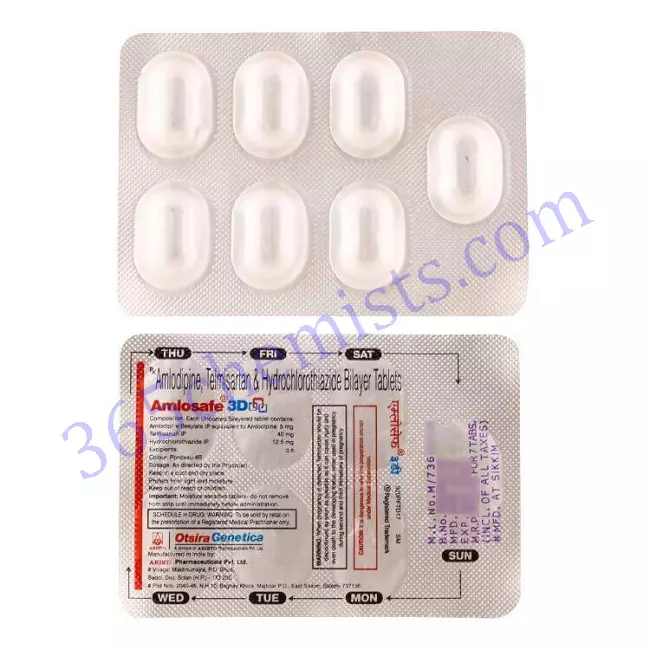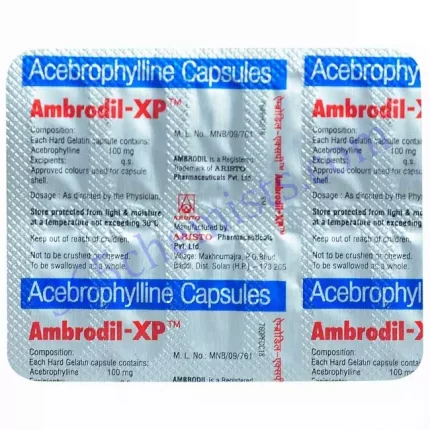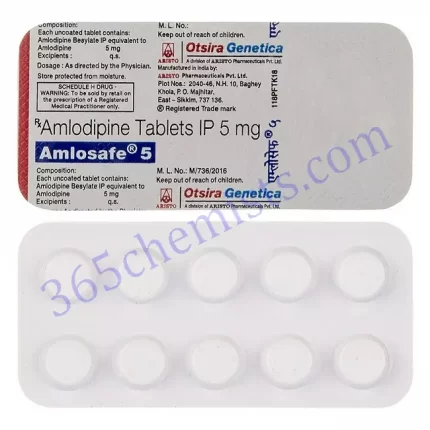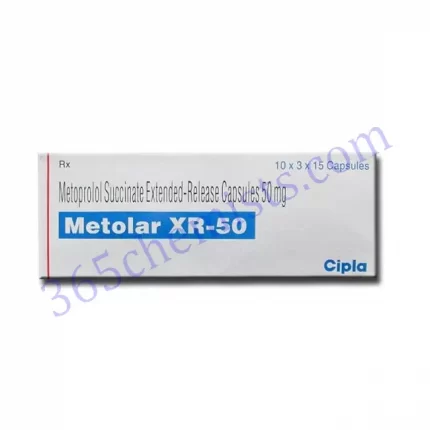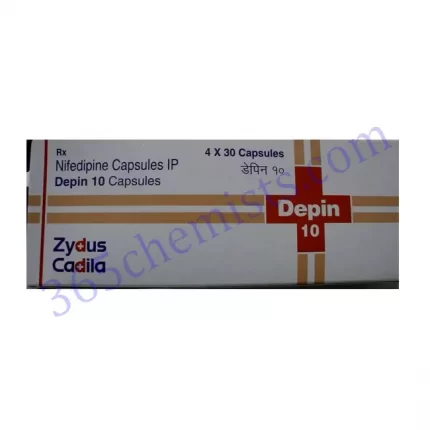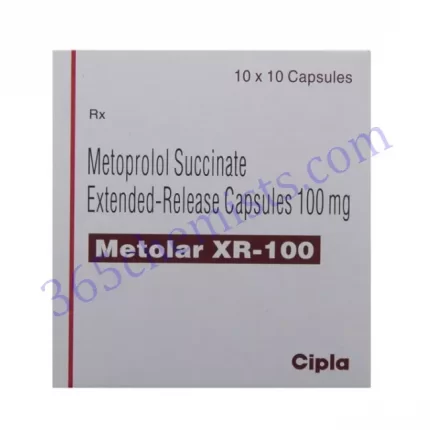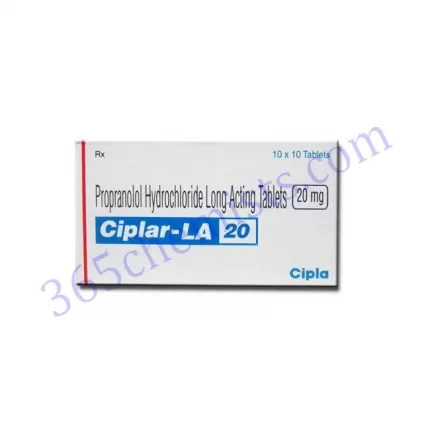Amlosafe 3D Tablet (Telmisartan 40mg/Amlodipine 5mg/Hydrochlorothiazide 12.5mg): A Comprehensive Overview
The active components of the medication known as Amlosafe 3D Tablet are Telmisartan, Amlodipine, and Hydrochlorothiazide. This medication comes in the form of a combination tablet. It is a medication that is frequently recommended for the treatment of hypertension, also known as high blood pressure. In the following paragraphs, we will present a comprehensive overview of Amlosafe 3D Tablet, including topics such as its applications, dosage, potential adverse effects, and safety considerations.
What is Amlosafe 3D Tablet?
Oral drug that comes in tablet form, Amlosafe 3D Tablet can be taken by mouth. Telmisartan, Amlodipine, and Hydrochlorothiazide are the three active components that may be found in each individual tablet. The angiotensin II receptor blocker (ARB) telmisartan, the calcium channel blocker (CCB) amlodipine, and the thiazide diuretic hydrochlorothiazide are the three different types of medications. Despite their individual methods of action, the drugs in this combination operate together to bring the patient’s blood pressure down.
Uses of Amlosafe 3D Tablet
The primary use for the Amlosafe 3D Tablet is the management of hypertension (high blood pressure) in patients who require many drugs in order to achieve optimal blood pressure control. By relaxing the blood vessels, lowering peripheral vascular resistance, and encouraging diuresis (increased urine production), the combination of telmisartan, amlodipine, and hydrochlorothiazide can help decrease blood pressure.
Dosage and Administration
It is possible for the recommended dosage of Amlosafe 3D Tablet to change based on the individual’s current blood pressure reading, their overall health, and their reaction to the drug. It is essential to take the medication exactly as directed by the healthcare practitioner and to completely adhere to the dosage that has been recommended. In most cases, the tablet should be swallowed orally once day, either with or without meals.
During treatment with Amlosafe 3D Tablet, it is imperative that the patient maintain consistent blood pressure monitoring. It is essential to go to all of the appointments that have been planned for you and to keep your healthcare provider updated on any shifts in your blood pressure readings or symptoms.
Related Product
Amlosafe 2.5mg Tablet
Amlosafe 5 Tablet
Amlosafe TM 40 Tablet
Amlosafe LS 5/5mg Tablet
Amlosafe H Tablet
Amlosafe AT Tablet
Amlosafe 3D Tablet
S-Amlosafe 2.5mg Tablet
S-Amlosafe 5mg Tablet
Side Effects and Precautions
Side effects are possible with the use of any drug, including Amlosafe 3D Tablet. The following are examples of common adverse effects:
- Dizziness and Lightheadedness: As a potential side effect of taking Amlosafe 3D Tablet, some people may experience feelings of dizziness or lightheadedness. It is essential to rise gently from a seated or laying posture in order to reduce the likelihood of experiencing dizziness.
- Urination Increase Because it is a diuretic, hydrochlorothiazide causes an increase in the amount of urine that is produced. This could cause you to have to urinate more frequently. If the problem of frequent urination persists, it is critical to maintain an adequate level of hydration and to speak with a healthcare expert.
- Electrolyte Imbalance Hydrochlorothiazide has been linked to causing electrolyte imbalances in patients, including low potassium, sodium, and magnesium levels. It may be required to perform routine monitoring of electrolyte levels, particularly in persons who are at a higher risk, such as those who have kidney difficulties or who are taking other medications that can influence electrolyte balance.
It is essential to keep in mind that not everybody has these unwanted effects, and a lot of people are able to manage Amlosafe 3D Tablet just fine without having any negative responses at all. It is recommended that further examination be sought from the healthcare practitioner in the event that any of the potential adverse effects continue to be bothersome or alarming.
Individuals who have pre-existing medical issues, such as kidney illness, liver disease, or diabetes, require additional precautions in order to avoid potential complications. The medical history of the individual will be evaluated, and the provider of healthcare will provide appropriate advice for the secure and efficient usage of Amlosafe 3D Tablet.
Mechanism of Action
The Amlosafe 3D Tablet contains three active components, each of which exerts its effect via a distinct mechanism:
- Telmisartan (ARB): Telmisartan is an angiotensin II receptor blocker that acts by selectively preventing the binding of angiotensin II to its receptors, more especially the angiotensin II type 1 (AT1) receptors. Telmisartan works to lower blood pressure by suppressing the activity of angiotensin II. This, in turn, helps to relax and broaden the blood vessels, which in turn reduces the resistance of the peripheral vascular system.
- Amlodipine, also known as a calcium channel blocker (CCB), prevents calcium from entering the smooth muscle cells that line the artery walls. This results in a drop in peripheral vascular resistance and a fall in blood pressure, both of which are caused by the blood vessels relaxing and expanding as a result of the effect.
- Hydrochlorothiazide, often known as thiazide diuretic, is a substance that stimulates the production of urine by increasing the amount of salt and water that is excreted by the kidneys. This contributes to a decrease in blood volume as well as a reduction in blood pressure.
By integrating these three medications into a single pill, the Amlosafe 3D Tablet offers a holistic strategy for the management of blood pressure.
Important Considerations and Precautions
Individualised Dosage: The dosage of Amlosafe 3D Tablet should be decided by the healthcare provider depending on the individual’s blood pressure level, overall health, and response to the drug. This should be done so that the individual receives the most benefit from taking the medication. It is essential to take the medication exactly as directed by the healthcare practitioner and to completely adhere to the dosage that has been recommended.
Interactions with Other Medications The Amlosafe 3D Tablet may have an interaction with other medications, such as lithium, nonsteroidal anti-inflammatory drugs (NSAIDs), and other antihypertensive medications. Because of these interactions, the effectiveness of the Amlosafe 3D Tablet may be diminished, and the user may be more likely to have unwanted side effects. It is imperative that the patient disclose all drugs that they are currently taking to the healthcare professional in order to prevent any potentially harmful interactions.
Monitoring of Blood Pressure and Electrolyte Levels During therapy with Amlosafe 3D Tablet, it is imperative that the patient undergo routine monitoring of their blood pressure as well as their electrolyte levels. These levels should include potassium, sodium, and magnesium. This is of utmost significance for people who have already been diagnosed with renal disease, as well as for those who are taking other medications that may interfere with electrolyte balance.
Amlosafe 3D Tablet use is not advised during either pregnancy or nursing due to the potential for serious adverse effects. If you are contemplating a pregnancy, if you are already pregnant, or if you are breastfeeding, it is essential to have a conversation with your healthcare provider about appropriate alternative alternatives.
Conclusion
A combination drug known as Amlosafe 3D Tablet (Telmisartan 40 mg, Amlodipine 5 mg, and Hydrochlorothiazide 12.5 mg) is used for the treatment and control of hypertension (also known as high blood pressure). Amlosafe 3D Tablet helps to decrease blood pressure through numerous different processes because it combines the effects of a calcium channel blocker, an angiotensin II receptor blocker, and a diuretic all into one pill. For the Amlosafe 3D Tablet to be used in a manner that is both safe and effective, it is necessary to adhere to the dosage that has been recommended, to regularly monitor one’s blood pressure, and to maintain an open line of communication with one’s healthcare practitioner. The management of hypertension and the monitoring of treatment response and side effects are both extremely important tasks that fall under the purview of healthcare professionals.

